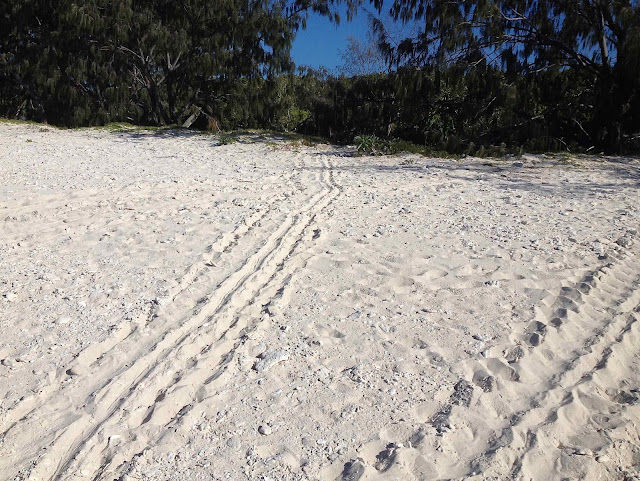"The Narrows" is a tidal waterway between Curtis Island and the mainland.
The shallowest region, "The Crossing" is actually a vehicle track and cattle crossing at low tide and hence is only navigable to boats at high tide, when the northern and southern arms of the channel are linked. The tide ebbs and floods in reverse directions on either side of the Crossing. The trick is to sail in with the rising tide, pass over the Crossing at the peak, and then get flushed south as the tide ebbs.
 | ||
| Channel marker for boats crossing at high tide: post and rails for stock crossing at low tide. |
The waterways on either side of the Narrows are home to a rare species of dolphin, new to me, called the Australian snub-fin. We saw two pods of snubfins feeding in the muddy water near mangroves at either end of the Narrows, but it is very hard to get a good photo, so I have shared this one courtesy of Guido Parra, QLD Government. The snub fin is not officially endangered, but they must be vulnerable to the industry and shipping around Gladstone.
Once you navigate the Narrows, you end up in Gladstone Harbour, and a spider's web of navigation channels. Even non-sailors will appreciate the intricacies of this chart.
Running this gauntlet was an adventure in itself; the reward being our escape back into the open ocean and a nice sail to our next anchorage at Pancake Creek.
 |
From Pancake Creek, we sailed north-east to Fitzroy Reef, breathing a sigh of relief as we left the dusty coast behind.
The excitement of heading offshore, and the prospect of watching the sun set over the ocean never grows old.
 |
Fitzroy Reef is one of the Bunker Group. Although Cook and Flinders undoubtedly sailed through them, they were named by Captain Eber Bunker, of the whaling ship, Albion, in 1804. They also form part of the Capricornia Cays National Park.
Web Link: Capricornia Cays National Park
Web Link: Capricornia Cays National Park
Fitzroy Reef did not disappoint. We anchored just inside the fringing reef and it offered wonderful diving and spearfishing.
Then it was on to Lady Musgrave, for 5 idyllic days.
The noddies and terns were roosting in great numbers.
And there was the added bonus of green sea turtles mating in profusion across the lagoon; seemingly oblivious to voyeurs.
The Man in the Grey Suit
In Fitzroy and Lady Musgrave Lagoons, we also had a series of shark encounters. White-tip reef sharks were most common. These are ubiquitous and almost harmless unless you get between them and a fish they have decided to eat.
Black-tips were also common. Here you can see about 10 swimming in the shallow water feeding on crustaceans.
Then there were larger sharks, sometimes glimpsed in the deeper channel, or from the safety of the inflatable. We never identified this one, who was more substantial than our regular visitors, but we felt he was worthy of respect.
We were settling down one evening to a meal of fresh-caught coral trout and stripey. Embers of the setting sun glowed on the horizon and the water took on a silky black sheen as night swept in.
We drained our cooking oil overboard and within 5 minutes a scimitar-shaped fin sliced through the water towards the back of the boat. It was clearly a shark, and not a small one. Although the light was too low for us to see the rest of its body, the unusual shape of its fin gave it away (example below). We later identified it as a hammerhead. In the lagoon. Yikes.
Two days later, we were anchored in Lady Musgrave Lagoon, only a hundred metres from the island.
The sun was out and the water was crystal clear. I was sitting on the bow contemplating a swim, when I saw a dark shape swimming towards the boat.
Its fin broke the surface and as it passed beneath me, the sun caught the beautiful pattern on its back. As usual, I was not quick-witted enough to get a photo of my own, but it looked like this ...
 |
| Courtesy of www.funpeep.com |
The legend of the 3 metre tiger shark was born. Although, really, it wouldn't have mattered how long it was; it was still an amazing thing to see, and I am happy I was not in the water with it. Not surprisingly, it took some persuasion for our visitors to re-enter the water, but they were safe because they stuck close together.
It was a wonderful finish to our cruising season. There was some stormy weather on our way south to Bundaberg; this front passed right over, whipping the sea into a wild ride for a few hours.
But Alchemy 1 saw us safely through and the sea settled again. In this photo (courtesy of N.H.) the crepuscular rays of the setting sun arced all the way across to the eastern horizon.


































What a fantastic adventure!
ReplyDeleteI would not venture into the water with tiger sharks, especially with what appears to be such limited visibility!
Thanks for sharing your photos and stories.
Happy new year! :)